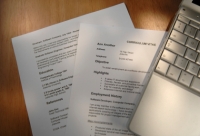 |
by former
recruiter David Alan Carter
real-life examples of resume objectives
↓
Resume Objective - The Resume Format Best Resume Format - Chronological or Functional?When you get right down to it, prospective employers simply want to know what you can do for them. To a large extent, they will answer that question by evaluating your work history: what you have done, how well you have done it, and for how long. Organizing that information on an effective resume breaks down generally into one of two formats: a chronological resume format or functional.
The Chronological ResumeTo Professional Resume Writers, the most predominant resume format is the chronological--and for good reason (which we'll get to in a moment). It plays out just like it sounds: it follows your work history in reverse chronological order, backward from your current job, listing companies and dates and responsibilities. The past ten years of experience is considered to be the most important. Experience prior to that should generally be left off the chronological resume format –unless that experience happens to be particularly relevant to the position you’re seeking, so much so that it outweighs your more recent work. Key points to keep in mind for the chronological resume format:
For each job title, I like to write a couple of lines to sum things up, then follow with a short series of bullet points that each identify a particular achievement–quantified with numbers when possible (e.g. "reorganized department and streamlined workflow generating an operational savings of $150K annually," or "supervised welding crew of three to deliver key contract 20% under budget," or "organized student career day resulting in a 95% parent participation"). Don’t go overboard–more than 5 or 6 bullets, and your reader will start to lose interest. Continue in this manner throughout your prior titles. It’s probably a good idea to show a slightly increasing number of bullet points--accomplishments--as time has progressed (i.e., three bulleted accomplishments under a job title from ten years back, 5 or 6 bulleted accomplishments from your most recent title). The Functional ResumeA lesser used resume format is the functional resume: instead of highlighting company names, job titles and employment dates, it draws attention instead to skill sets and achievements. These are divided into 2-4 functional areas, or areas of specialization, that the writer feels would best demonstrate his or her value to a prospective company. Each area of specialization would identify specific achievements relevant to that area and float independently of the companies and titles associated with that experience. Such achievements are commonly posed via bullet points; 3-6 under each functional area should do it. To give you an idea, areas of specialization might include the following:
There are no hard and fast rules when it comes to selecting these functional areas, other than keeping them relevant to the desired position. So start by focusing on your desired position; research it, contemplate it, sketch out 2-4 areas that would fit hand-in-glove with that position. Now scour your work history, lift out achievements and drop them into the most appropriate of these areas.
Who Should Use What?The chronological resume is the most effective resume format when one’s work history is stable, professional growth consistent, and career goals remain in the same employment field. Conversely, because skill sets and tailored accomplishments are emphasized over employment chronology, the functional resume format has value especially for those who have gaps in their work history, or who have switched jobs frequently, or when current responsibilities don’t relate to a desired job. The functional format makes sense for someone looking to jump start a new career in a new field, or whose volunteer or non-work experience may be of more value to a prospective company than that demonstrated by a spotty or non-existent work record. But there is a caveat... Think Twice Before Using A Functional FormatThose considering a functional resume should be forewarned. Many hiring officials Where we go from here: Don't blow it in the first few words. Your resume objective is critical in keeping the hiring official reading your resume. If you haven't already read it, take a quick look at The Resume Objective. David Alan Carter is a former headhunter and the founder of Resume One of Cincinnati. For more than ten years, he personally crafted thousands of resumes for satisfied clients from all occupational walks of life--entry level to executive.
| ||||||
You're Here: The Resume Objective... It's Not About You > The Resume Format
|
Your Resume Objective is not about you. Or so says this former recruiter
and pro resume writer. Here's information on how to empathize with the hiring official, and write a killer Resume
Objective. Plus, real life examples of resume objectives
from the pages of successful resumes.
© Copyright 2008-Present, Webstreet Properties LLC. All Rights
Reserved.
 Each resume format carries baggage, and which one you decide to use should be dictated
by your individual circumstances.
Each resume format carries baggage, and which one you decide to use should be dictated
by your individual circumstances.

 have come to associate the functional format with a candidate seeking to hide some aspect of his
work history. And for good reason–many are trying to do just that. While it can still be an effective resume,
choosing a functional format will send up a red flag in the eyes of many employers, something your resume will
have to overcome from the get go. Remember, resumes are initially used for screening... screening out
folks! Only the writer can determine whether the benefits of the functional format outweigh that
potential liability.
have come to associate the functional format with a candidate seeking to hide some aspect of his
work history. And for good reason–many are trying to do just that. While it can still be an effective resume,
choosing a functional format will send up a red flag in the eyes of many employers, something your resume will
have to overcome from the get go. Remember, resumes are initially used for screening... screening out
folks! Only the writer can determine whether the benefits of the functional format outweigh that
potential liability. 